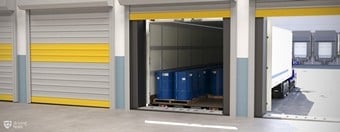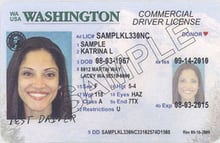

All your missed questions are saved
automatically for extra practice.




It's a practice test that's automatically made up of all your missed questions. Once you finish this test, you’ll be able to revisit your Challenge Bank™ to practice and sharpen your skills.
View All PlansAdding difficult questions to Challenge Bank™ is an exclusive Premium feature. Unlock access to 650+ exam-like questions, a Pass Guarantee, personalized study plans, and more.
View All PlansFree Washington CDL HazMat Endorsement Practice Test 2026
| 90-100 | => | 24% |
| 80-89 | => | 29% |
| 70-79 | => | 25% |
| 60-69 | => | 18% |
| <60% | => | 3% |
Washington State Apples, the Space Needle, Pike’s Place, and the coffee culture, added to Washington’s diverse landscape, and you’ll find lots to enjoy as you drive through the state. Since you’re here, you must be interested in the opportunities available once you’ve added the Hazardous Materials (Hazmat) endorsement to your Commercial Driver’s License (CDL). For 18–20-year-olds, Washington allows you to obtain a CDL and drive within state lines; however, you cannot obtain the hazmat endorsement until you reach the age of 21 per federal law. For those 21 and older, let’s take a look at this endorsement.
The U.S. government has labeled certain materials as hazardous and the Hazmat endorsement permits drivers to transport these items. They range from explosives to certain types of fuel, industrial chemicals, radioactive materials, and infectious substances. “Yikes! What am I getting myself into?!” Don’t worry. The most important objective of this endorsement process is to ensure your safety and protect the people and environment in your driving area.
To add this endorsement, you’ll need to pass a Transportation Security Administration (TSA) fingerprinting and background check. Taking care of that requirement is step one. While you wait for these results, you can tackle the second requirement: the DOL knowledge test. The knowledge test includes topics like federal regulations, substance handling, material packaging, quantity limits, and transport configurations for hazardous materials. You’ll have to score 80% or higher. You’ll need 24 of them answered correctly (Washington CDL Handbook 2026).


Reviewed for legal and handbook accuracy
M.S., Chief Educational Researcher (ACES member)
Last verified for accuracy on
Real Washington drivers who passed first try
Verified student reviews • Shared with permission
About the Washington CDL
In the Evergreen State, there are multiple industries requiring a Hazmat endorsement. They include petroleum and fuel distribution (Shell and BP America have distribution facilities in the state), chemical manufacturing (Univar Solutions is headquartered in Belleview), agricultural chemicals (Wilbur-Elis and Helena Agri-Enterprises), waste management and environmental sciences (Clean Harbors and Stericycle), and industrial gas suppliers like Airgas and Praxair. What a list! The good news is we have simplified the process.
Our online Washington CDL HazMat Endorsement practice tests are designed to focus on what’s truly relevant instead of the mountain of information you’ll find online and mimic what you will face on the official DOL test. Don’t delay. Get your TSA requirements submitted and practice with our tests until they arrive. Then, go to the DOL with the necessary documents, pay the fees, and confidently pass the test.
More WA CDL test resources
Are you in another state?
- Alabama
- Alaska
- Arizona
- Arkansas
- California
- Colorado
- Connecticut
- Delaware
- District of Columbia
- Florida
- Georgia
- Hawaii
- Idaho
- Illinois
- Indiana
- Iowa
- Kansas
- Kentucky
- Louisiana
- Maine
- Maryland
- Massachusetts
- Michigan
- Minnesota
- Mississippi
- Missouri
- Montana
- Nebraska
- Nevada
- New Hampshire
- New Jersey
- New Mexico
- New York
- North Carolina
- North Dakota
- Ohio
- Oklahoma
- Oregon
- Pennsylvania
- Rhode Island
- South Carolina
- South Dakota
- Tennessee
- Texas
- Utah
- Vermont
- Virginia
- Washington
- West Virginia
- Wisconsin
- Wyoming
We know what it takes to pass. And we’ve got the proof.
Driver’s Ed is - nobody wants to set foot inside the DOL. That’s why millions of learners trust us for simple, visual, effective prep.
An official & trusted partner in driver education
We are an officially recognized FMCSA Entry-Level Driver Training provider and a proud partner to over 2,500 libraries. We work with safety organizations like GHSA and the National Safety Council to help create safer roads for everyone.






A smarter way to study
Challenge Bank™
Our trademarked system automatically saves questions you miss, creating personalized tests that target your weak spots until you’ve mastered the material.
AI-powered feedback
Get smarter as you study. Our new AI-powered feedback provides detailed, question-level insights to help you understand the why behind each answer.
Interactive handbook
Go beyond the boring black-and-white manual. Our interactive handbook lets you read, listen with an MP3 audio version, or even chat with it to find the information you need, faster.
We build our practice questions from the current 2026 WA Driver Handbook and refine them using patterns recent test‑takers report.
Driver handbook • Knowledge‑test/permit overview • Fees & ID requirements • Office/appointment info
We mirror recurring themes (e.g., right‑of‑way traps, sign look‑alikes) and use similar distractors and wording styles.
We don’t collect or publish actual test items and we’re not affiliated with DOL.

